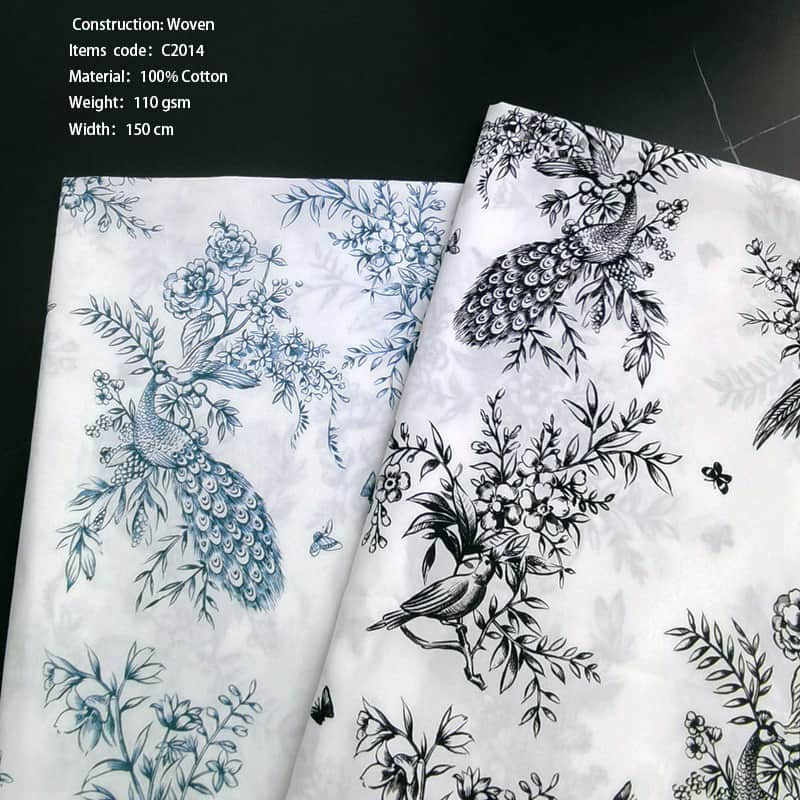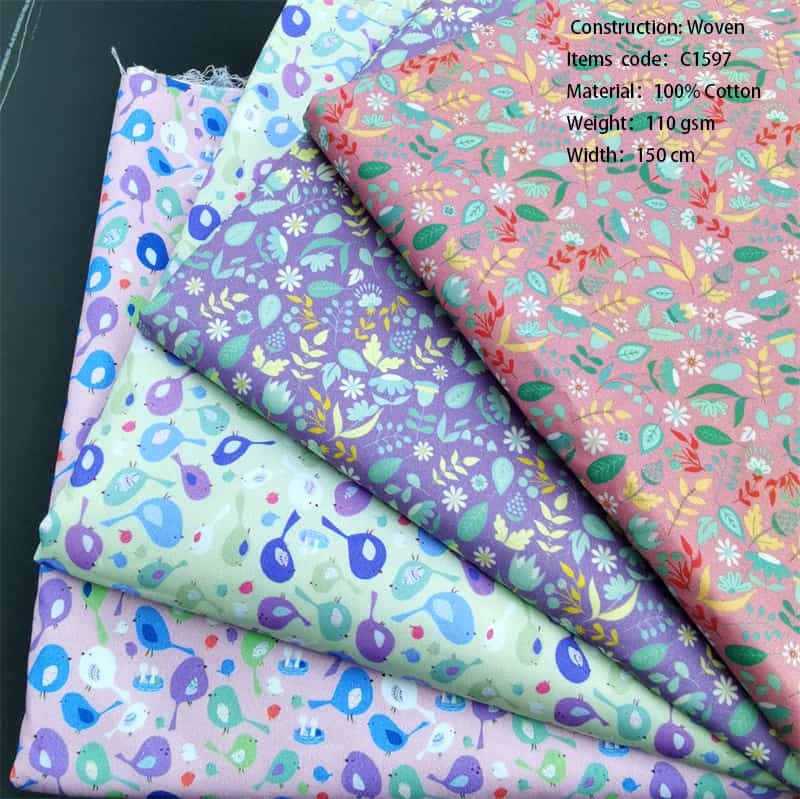
The effect of fibre and weave shrinkage
The fibres themselves will swell to some extent when they absorb water. Usually the swelling of fibres is anisotropic (except for nylon), i.e. the length shortens and the diameter increases. The difference between the length of the fabric before and after it is put into water and the percentage of its original length is usually referred to as the shrinkage rate. The stronger the water absorption capacity, the more intense the swelling, the higher the shrinkage and the worse the dimensional stability of the fabric.
The length of the fabric itself is different from the length of the yarn (silk) used, and the difference is usually expressed in terms of the weaving shrinkage.
Weave shrinkage (%) = [yarn (silk) yarn length – fabric length] / fabric length
After the fabric is put into water, the fabric length is further shortened due to the dissolution of the fibres themselves, resulting in a shrinkage rate. The size of the shrinkage varies with the weaving shrinkage of the fabric. The fabric itself has a different organisation and weaving tension, the weaving shrinkage rate is different. Weaving tension is small, the fabric is close and thick, the weaving shrinkage rate is large, the shrinkage rate of the fabric is small; weaving tension is large, the fabric is loose and thin, the weaving shrinkage rate is small, the shrinkage rate of the fabric is large. In the dyeing and finishing process, in order to reduce the shrinkage rate of the fabric, often use the pre-shrinkage finishing to increase the weft density, weaving shrinkage rate in advance, so as to reduce the shrinkage rate of the fabric.

Causes of shrinkage.
(1) Fibres in spinning, or yarn in weaving and dyeing, the yarn fibres in the fabric are elongated or deformed by external forces, while the yarn fibres and fabric structure produce internal stress, in the static dry relaxation state, or static wet relaxation state, or in the dynamic wet relaxation state, full relaxation state, different degrees of internal stress release, so that the yarn fibres and fabric back to the initial state.
(2) Different fibres and their fabrics have different degrees of shrinkage, depending on the characteristics of the fibres – hydrophilic fibres have a greater degree of shrinkage, for example cotton, linen, viscose and other fibres; hydrophobic fibres have a lesser degree of shrinkage, for example synthetic fibres.
(3) Fibres in the wetted state, due to the role of liquid immersion under the effect of expansion, so that the diameter of the fibres become larger, such as in the fabric, forcing the fabric interweaving point of the radius of curvature increases, resulting in a shortening of the length of the fabric. For example, cotton fibres in the role of water expansion, cross-sectional area increased by 40 ~ 50%, the length increased by 1 ~ 2%, while synthetic fibres are shrinkage to heat, such as boiling water shrinkage, etc., generally about 5%.
(4) textile fibres under heat conditions, the form and size of the fibres change and shrinkage, cool down also can not return to the initial state, known as fiber heat shrinkage. The percentage of length before and after thermal contraction is called thermal contraction rate, generally to boiling water shrinkage test, in 100 ℃ boiling water, the percentage of fiber length contraction as a representation; also useful hot air way, in more than 100 ℃ in the hot air to measure the percentage of its contraction, but also useful steam way, in more than 100 ℃ in the steam to measure the percentage of its contraction. Fibres also perform differently under different conditions due to their internal structure and the temperature and time they are subjected to heat. For example, the boiling water shrinkage of processed polyester staple fibres is 1%, the boiling water shrinkage of vinyls is 5% and the hot air shrinkage of chlorine spandex is 50%. Fibres in textile processing and their dimensional stability are closely related and provide some basis for the design of the post-process.

Typical fabric shrinkage rates are
Cotton: 4 – 10%
Chemical fibres :4 – 8 %
Cotton polyester:3.5 – 5 5%
natural white fabrics:3%
wool blue fabric:3 – 4 %
poplin:3-4.5%
Print fabrics:3 – 3.5 %
twill fabric:4%
labour cloth fabric:10%
rayon:10%

Affect the shrinkage rate causes.
1, the raw material fabric of different raw materials, shrinkage rate is different. Generally speaking, moisture-absorbent fibers, fiber expansion after immersion, diameter increases, length shortens, the shrinkage rate is large. Such as some viscose fiber water absorption rate of up to 13%, and synthetic fiber fabric moisture absorption is poor, its shrinkage rate is small.
2, density of fabric density is different, shrinkage rate is also different. Such as warp and weft density is similar, its warp and weft shrinkage rate is also close. By the density of the fabric, the warp shrinkage is large, and vice versa, the weft density is greater than the weft density of the fabric, the weft shrinkage is also large.
3, yarn count thickness of different fabrics, shrinkage rate is also different. Yarn count thick fabric shrinkage rate is large, yarn count fine fabric shrinkage rate is small.
4, production process fabric production process is different, the shrinkage rate is also different. Generally speaking, the fabric in the weaving and dyeing process, the fiber to stretch many times, long processing time, apply tension to the larger fabric shrinkage rate, and vice versa is small.
5, fiber composition of natural plant fibers (such as cotton, hemp) and plant recycled fibers (such as viscose) and synthetic fibers (such as polyester, acrylic), compared to the moisture absorption and expansion, so the shrinkage rate is larger, while wool is due to the fiber surface of the scale structure and easy to felt, affecting its size stability.
6, fabric structure in general, woven fabrics are better than knitted fabrics in terms of dimensional stability; high-density fabrics are better than low-density ones. In the woven fabric, the general shrinkage rate of plain fabric is smaller than flannel fabric; and knitted fabric, flat needle organization shrinkage rate is smaller than ribbed fabric.
7, production and processing process because the fabric in the dyeing, printing, finishing process, will inevitably be subject to machine stretching, so there is tension in the fabric. However, the fabric in contact with water is easy to lift the tension, so we will find the fabric shrinkage after washing. In the actual process, we generally use pre-shrinkage to solve this problem.
8, washing care process Washing care includes washing, drying and ironing, each of these three steps will affect the shrinkage of the fabric. For example, the dimensional stability of hand-washed samples is better than that of machine-washed samples, while the temperature of washing will likewise affect its dimensional stability. In general, the higher the temperature, the less stable it is. The way in which the samples are dried also has a greater impact on the shrinkage of the fabric.
Commonly used drying methods are, drip drying method, metal mesh flat method, hanging dry drying method and tumble drying method. Among them, the drip drying method has the least influence on the size of the fabric, while the rotating cylinder arch drying method has the greatest influence on the size of the fabric, and the remaining two are in the middle.
In addition, according to the composition of the fabric to choose a suitable ironing temperature, can also improve the shrinkage of the fabric. For example, cotton and linen fabrics can improve their size shrinkage by ironing at high temperatures. But not the higher the temperature the better, for synthetic fibres, high temperature ironing will not improve its shrinkage rate, but will damage its performance, such as fabric stiff and brittle, etc.
























